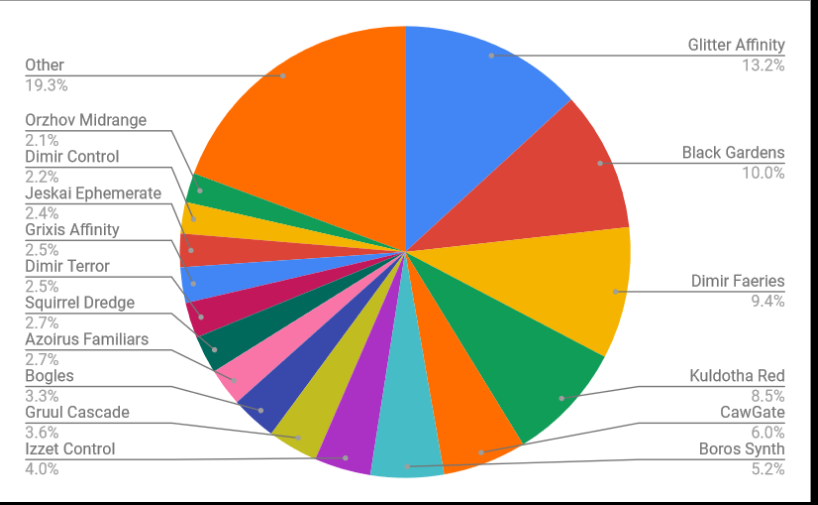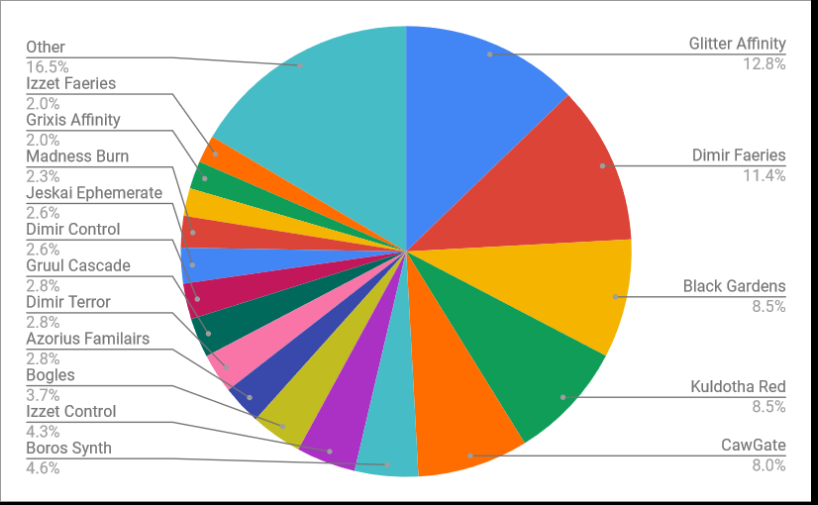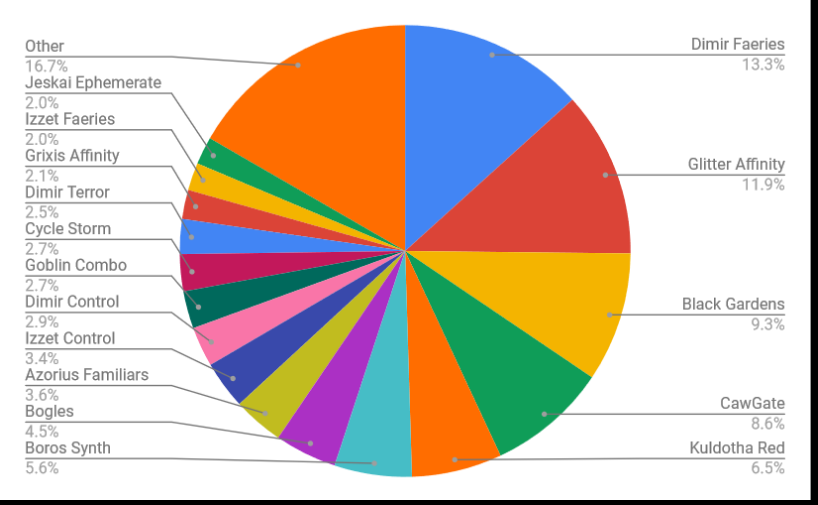Want to learn more about the metrics I use in tracking the metagame? You can find an explainer here.
The first four weeks of Murders at Karlov Manor season showed Pauper the strength of All That Glitters. After months of living under Monastery Swiftspear, the running sneaker was lifted from the format’s throat and things largely settled. Things were dynamic, at least in the early goings, until the weekend of March 2-3 where Glitter Affinity broke on to the scene in a big way. The strategy took 10 of the 24 possible Top 8 slots in the three Challenges while also going on to win the Qualifier event. All told 11 of the 32 Top 8 slots available went to Glitter Affinity.
Understandably this caused a ruckus. The format had just started to recover from the dominant stretch of red and All That Glitters represented a threatening damage engine. While it was slower and more fragile than Monastery Swiftspear, it had a form of haste and could turn any creature into a game ending attacker. This coupled with the cheap interaction available to the deck painted a target on its back. It was not long after that first weekend of March that the calls for a ban began to ring throughout the Pauper-sphere.

That is where these next four weeks begin – with Glitter Affinity at the height of its power. The above chart displays the total Challenge metagame – that is every deck entered into a Magic Online Challenge – over the weekends starting March 9-10 and ending March 30-31. Glitter Affinity – that is the Azorius build – made up 13.2% of the overall metagame. Boros Synth includes builds that also run All That Glitters, but at most that’s a bit more than half of those builds over the span. Sprinkle in 0.75% of the field running Jeskai Glitters and you end up with a most popular macro-strategy that clocks in at right around 16% of the total field for a month long span.
Behind Glitter Affinity there are a variety of decks including black based midrange in Black Gardens, a flash-control deck in Dimir Faeries, low to the ground aggro in Kuldotha Red, and blue-white “tap-out” control in CawGate. The last month saw solid competitive variety in the Challenge metagame but the specter of Glitter Affinity loomed large. Being forced to play around the aura represented a new play pattern, one that was largely resilient to what Pauper had been presenting.
Think about Rancor. Rancor represented significant damage output over time thanks to its ability to come back from the graveyard. During its heyday there were absolutely better targets for Rancor, including Skarrgan Pit-Skulk and Silhana Ledgewalker, but slapping it on a Nettle Sentinel or a Nest Invader could get the job done. All That Glitters trades the long game for more immediate pressure and while Ornithopter and Gingerbrute might be the best ones to wear the shiny mantle, Thraben Inspector and Novice Inspector will do in a pinch. Unlike Stompy, Glitter decks can draw to their damage engine with ease and deploy several in a single turn. It is the combination of aura-as-threat and the low barrier to getting it into play that upset the established lanes of the format.

We start to see a different picture when we look exclusively at the make up of the Top 32 finishers. Glitter Affinity still is the most popular, but takes a small step back. Dimir Faeries leapfrogs Black Gardens while Kuldotha Red remains consistent. CawGate also ticks up a bit but stands pat in the fifth position.
There are a few ways to look at this. The first (and perhaps most obvious) is that Dimir Faeries has been an incredibly popular deck over the past two weeks. However part of the reason it may be popular is because it presents a counterweight to Glitter decks. Dimir has access to removal and countermagic in enough volume to answer the biggest threats out of Glitter Affinity. Dimir Faeries can sit back and play a Flash game with Spellstutter Sprite before going on the offense, all while hitting land drops and setting up haymakers in the form of Murmuring Mystic or Thorn of the Black Rose. Dimir Faeries is set up to prevent Glitter from the line described above of casting multiple auras in a single turn.
Is this enough? That’s hard to say. If a deck can help keep Glitter in check, then what about the other options? That Dimir Faeries is able to do this does not mean All That Glitters is healthy to have in the format (not does it prove the opposite, to be clear). Can other decks succeed against Glitters is the real key. Given what we laid out above it is plausible. At the same time, is it acceptable if part of the counterplay involves a mechanic largely limited to a single color in countermagic?
There are other options available. Cards like Dispeller’s Capsule, Cathar Commando, or Seal of Primordium can come down and prevent an All That Glitters from sticking. There are other Disenchant style effects as well that could stifle Glitter decks. This is to say nothing of simply cutting the creature out from underneath the aura. These angles are about keeping Glitters in mind during deck construction and the games themselves. And the format has started to see the results of people doing just that, if the Winner’s Metagame is any indication.

The Winner’s Metagame looks at the Top 32 for each Challenge. It takes into account the Swiss performance and the total of all wins less all losses for an archetype. These are weighted based upon share of the Top 32. All together this provides an impression of what to expect at the top of the metagame. Here we can see that over the past month Dimir Faeries has had the largest share of the Winner’s Meta. Glitter Affinity also loses a bit more than a percentage point from its overall presence, which could indicate that people are adjusting their game plans to better fight the machine menace.
Comparing to the first four weeks (which had some confounding data due to a corrupted set of week one Challenges) we can see a fairly stark difference. Glitter Affinity ended the first month of Karlov Manor season with 15.92% of the Winner’s Metagame while Dimir Faeries lagged behind at 5.53%. Faeries is nothing if not malleable and by making small adjustments (as well as other shifts in the metagame), the strategy has been able to climb back to the top of the heap.
Adjusted Meta Score Above Replacement gives us another look at how well different strategies are performing in relationship to one another. During the first month Glitter Affinity was lapping the field with an aMSAR of 2.22 while the next best deck – Kuldotha Red – came in with a score of 0.61. The leader over the second four weeks is Dimir Faeries with a more reasonable score of 1.37. While Faeries has a clear lead, the next cluster is not as far behind: Glitter Affinity with 0.78, Black Gardens and CawGate both with 0.68, Boros Synth with 0.5. All of this points to a metagame that is less polarized that it appeared after that one week in early March.
Pauper is, in many ways, stable. That is not to say things are stagnant or static but rather the meta is established. The top decks are largely known and from week to week adjustments in game plan and composition are rewarded. The aMSAR leader for each week of the last month cycled between four strategies – Glitter Affinity, Black Gardens, Dimir Faeries, and Dimir Control.
None of this, however, takes away from the pressure All That Glitters exerts on the format. It is the preeminent threat and, as discussed earlier, can create situations that force the opponent in a reactive state from the get go. This has continued the trend that began with Modern Horizons 2. From Chatterstorm and pre-ban Affinity to Relay Storm to Kuldotha Red, for nearly three years Pauper has been a format more defined by offense than defense. As things begin to settle we return to the old adage made famous (perhaps apocryphally) by David Price: there are no wrong threats, only wrong answers. Whereas in the past a deck could get by simply by having an overwhelming endgame and a decent mix of removal spells, Pauper now demands adjusting to whatever the big bad of the week might be. Whether it’s an Aura or Gurmag Angler or a horde hasty goblin tokens, it is incumbent to make the right choices for what you expect to meet across the table. In other words, a failure to prepare is preparing to fail.
I want to take a moment to thank all my Patrons I am going to do my level best to keep providing you with the kind of content that brought you here in the first place. If you are interested in supporting my work, rewards for my Patreon start at just $1.
Can’t make a commitment to Patreon? I now have a Ko-Fi where you can make a one time contribution.
Looking for another way to support my work? Click here for my TCGPlayer affiliate link. Any purchases through the link let the folks there know you like my content!
